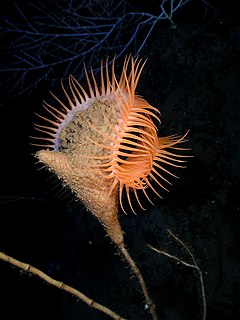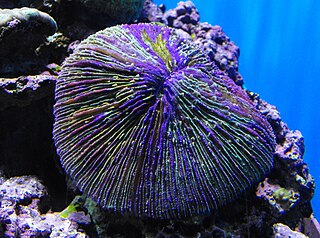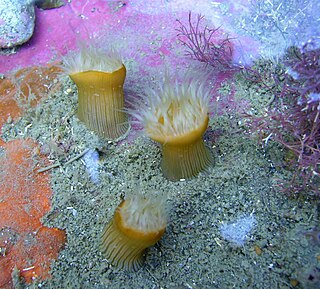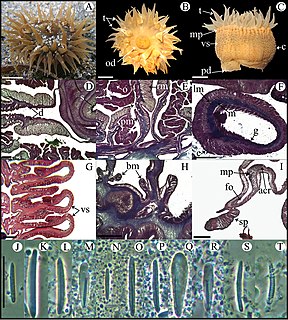
A polyp in zoology is one of two forms found in the phylum Cnidaria, the other being the medusa. Polyps are roughly cylindrical in shape and elongated at the axis of the vase-shaped body. In solitary polyps, the aboral end is attached to the substrate by means of a disc-like holdfast called a pedal disc, while in colonies of polyps it is connected to other polyps, either directly or indirectly. The oral end contains the mouth, and is surrounded by a circlet of tentacles.

Corals are marine invertebrates within the class Anthozoa of the phylum Cnidaria. They typically form compact colonies of many identical individual polyps. Coral species include the important reef builders that inhabit tropical oceans and secrete calcium carbonate to form a hard skeleton.

Anthozoa is a class of marine invertebrates which includes the sea anemones, stony corals and soft corals. Adult anthozoans are almost all attached to the seabed, while their larvae can disperse as part of the plankton. The basic unit of the adult is the polyp; this consists of a cylindrical column topped by a disc with a central mouth surrounded by tentacles. Sea anemones are mostly solitary, but the majority of corals are colonial, being formed by the budding of new polyps from an original, founding individual. Colonies are strengthened by calcium carbonate and other materials and take various massive, plate-like, bushy or leafy forms.

Scleractinia, also called stony corals or hard corals, are marine animals in the phylum Cnidaria that build themselves a hard skeleton. The individual animals are known as polyps and have a cylindrical body crowned by an oral disc in which a mouth is fringed with tentacles. Although some species are solitary, most are colonial. The founding polyp settles and starts to secrete calcium carbonate to protect its soft body. Solitary corals can be as much as 25 cm (10 in) across but in colonial species the polyps are usually only a few millimetres in diameter. These polyps reproduce asexually by budding, but remain attached to each other, forming a multi-polyp colony of clones with a common skeleton, which may be up to several metres in diameter or height according to species.

The sebae anemone, also known as leathery sea anemone, long tentacle anemone, or purple tip anemone, is a species of sea anemone belonging to the family Stichodactylidae and native to the Indo-Pacific area.

The Venus flytrap sea anemone is a large sea anemone that superficially resembles a Venus flytrap. It closes its tentacles to capture prey or to protect itself. It is a deep ocean species.

Aiptasia is a genus of a symbiotic cnidarian belonging to the class Anthozoa. Aiptasia is a widely distributed genus of temperate and tropical sea anemones of benthic lifestyle typically found living on mangrove roots and hard substrates. These anemones, as well as many other cnidarian species, often contain symbiotic dinoflagellate unicellular algae of the genus Symbiodinium living inside nutritive cells. The symbionts provide food mainly in the form of lipids and sugars produced from photosynthesis to the host while the hosts provides inorganic nutrients and a constant and protective environment to the algae. Species of Aiptasia are relatively weedy anemones able to withstand a relatively wide range of salinities and other water quality conditions. In the case of A. pallida and A. pulchella, their hardiness coupled with their ability to reproduce very quickly and out-compete other species in culture gives these anemones the status of pest from the perspective of coral reef aquarium hobbyists. These very characteristics make them easy to grow in the laboratory and thus they are extensively used as model organisms for scientific study. In this respect, Aiptasia have contributed a significant amount of knowledge regarding cnidarian biology, especially human understanding of cnidarian-algal symbioses, a biological phenomenon crucial to the survival of corals and coral reef ecosystems. The dependence of coral reefs on the health of the symbiosis is dramatically illustrated by the devastating effects experienced by corals due to the loss of algal symbionts in response to environmental stress, a phenomenon known as coral bleaching.

Stichodactyla mertensii, commonly known as Mertens' carpet sea anemone, is a species of sea anemones in the family Stichodactylidae. It is regarded as the largest sea anemone with a diameter of over 1 m (3.3 ft), the next largest being Heteractis magnifica, which has longer tentacles. This species has an oral disc that can be described as more ovoid than circular that contours to the surrounding substrate and is attached to the substrate by adhesive verrucae, which are wart-like projections. Its blunt or pointed tentacles are uniformly shaped, and are only about 1–2 centimetres (0.39–0.79 in) long. It contains obligate symbiotic zooxanthellae, and is a host to around half the species of anemonefish and one damselfish, Dascyllus trimaculatus.

The Fungiidae are a family of Cnidaria, commonly known as mushroom corals or plate corals. The family contains thirteen extant genera. They range from solitary corals to colonial species. Some genera such as Cycloseris and Fungia are solitary organisms, Polyphyllia consists of a single organism with multiple mouths, and Ctenactis and Herpolitha might be considered as solitary organisms with multiple mouths or a colony of individuals, each with its separate mouth.

Corallimorpharia is an order of marine cnidarians closely related to stony or reef building corals (Scleractinia). They occur in both temperate and tropical climates, although they are mostly tropical. Temperate forms tend to be very robust, with wide and long columns, whereas tropical forms tend to have very short columns with a wide oral disc and very short tentacles. The tentacles are usually arranged in rows radiating from the mouth. Many species occur together in large groups, although there are recorded instances of individuals. In many respects, they resemble the stony corals, except for the absence of a stony skeleton. Morphological and molecular evidence suggests that they are very closely related to stony corals.

Sea anemones are the marine, predatory animals of the order Actiniaria. They are named after the anemone, a terrestrial flowering plant, because of the colourful appearance of many. Sea anemones are classified in the phylum Cnidaria, class Anthozoa, subclass Hexacorallia. As cnidarians, sea anemones are related to corals, jellyfish, tube-dwelling anemones, and Hydra. Unlike jellyfish, sea anemones do not have a medusa stage in their life cycle.

Condylactis gigantea is a tropical species of ball anemone that is found in shallow reefs and other shallow inshore areas in the Caribbean Sea – more specifically the West Indies – and the western Atlantic Ocean including southern Florida through the Florida Keys. It is also commonly known as: giant Caribbean sea anemone, giant golden anemone, condylactis anemone, Haitian anemone, pink-tipped anemone, purple-tipped anemone, and Florida condy. This species can easily be seen growing in lagoons or in inner reefs as either individuals or loose groups, but never as colonies. They are often used as a model organism along with others in their genus for facultative symbiosis with monocellular algae.

Coral reef fish are fish which live amongst or in close relation to coral reefs. Coral reefs form complex ecosystems with tremendous biodiversity. Among the myriad inhabitants, the fish stand out as colourful and interesting to watch. Hundreds of species can exist in a small area of a healthy reef, many of them hidden or well camouflaged. Reef fish have developed many ingenious specialisations adapted to survival on the reefs.

Fungia is a genus of corals in the family Fungiidae. It is monotypic with the single species Fungia fungites, which is found growing on reefs in the Indo-Pacific.

Bartholomea annulata is a species of sea anemone in the family Aiptasiidae, commonly known as the ringed anemone or corkscrew anemone. It is one of the most common anemones found on reefs in the Caribbean Sea.

Anthothoe albocincta, or white-striped anemone, is a species of sea anemone in the family Sagartiidae. It is native to the coasts of Australia and New Zealand.

Heliofungia actiniformis is a solitary species of mushroom coral, a large polyp stony coral in the family Fungiidae. This coral is found in shallow water in the Indo-Pacific region. It is a zooxanthellate species. It is a popular coral in the reef aquarium trade; wild populations are threatened by disease, climate change, and over-collecting, and the species is considered vulnerable by the IUCN.

Diadumene cincta is a small and delicate, usually orange, sea anemone. It has a smooth slender column and up to 200 long tentacles, and normally grows to a length of up to 35 mm (1.4 in), with a base of 10 mm (0.4 in), but specimens twice this size have been recorded. Diadumene cincta is found in the northeastern Atlantic Ocean.

Manicina areolata, commonly known as rose coral, is a colonial species of stony coral. It occurs in shallow water in the West Atlantic Ocean and Caribbean Sea, sometimes as small solid heads and sometimes as unattached cone-shaped forms.

Bunodosoma cavernatum, commonly known as the warty sea anemone or the American warty anemone, is a species of sea anemone in the family Actiniidae. It occurs in the tropical and subtropical western Atlantic Ocean and the Caribbean Sea. It was first described in 1802 by the French naturalist Louis Augustin Guillaume Bosc, one of fourteen marine invertebrates described and named by him.



















